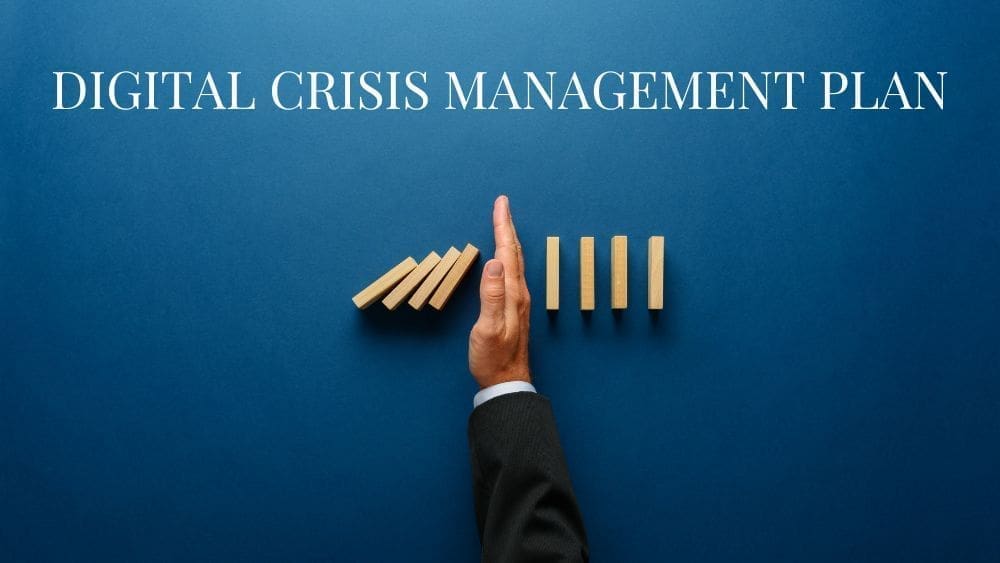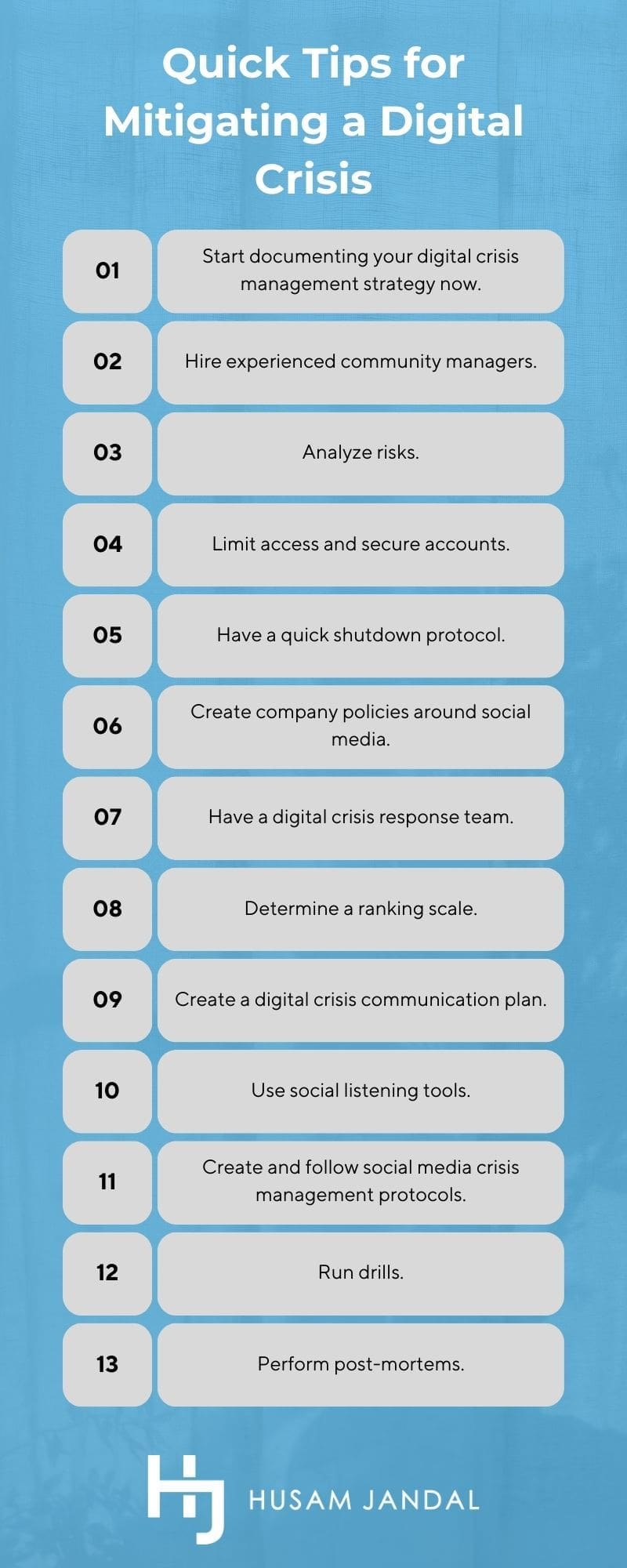 Warren Buffett once said, “It takes 20 years to build a reputation and five minutes to ruin it.” Five minutes might be generous in the digital age. For better or worse, ideas take on a life of their own online and spread like wildfire. Sometimes, that’s wonderful, like when one of your favorite posts goes viral. Other times, it’s going to hurt. However, having a digital crisis management plan will help you cope with the issue at hand and recover from it faster. Give me a few minutes and I’ll walk you through the basics.
Warren Buffett once said, “It takes 20 years to build a reputation and five minutes to ruin it.” Five minutes might be generous in the digital age. For better or worse, ideas take on a life of their own online and spread like wildfire. Sometimes, that’s wonderful, like when one of your favorite posts goes viral. Other times, it’s going to hurt. However, having a digital crisis management plan will help you cope with the issue at hand and recover from it faster. Give me a few minutes and I’ll walk you through the basics.
What is a Digital Crisis?
It can be considered a digital crisis anytime something happens online that can severely damage your reputation. I’ll give a few real-world examples.
- A well-known restaurant in the U.K. changed shipping companies, and the new company failed to deliver, resulting in massive shortages of customer favorites and hundreds of restaurants shutting down. Social media and news outlets lit up with negative sentiment. Even local police departments felt compelled to make posts about how the issue was not a police matter.
- A news outlet with hundreds of thousands of Twitter followers had to lay off a significant number of employees. The company failed to revoke access to one of its social media posters, who subsequently began uploading obscure gifs to the feed.
- An entertainment company with more than 100,000 followers had to perform layoffs. It, too, forgot to deactivate the company’s social media poster, who subsequently began giving the play-by-play from HR. Among the posts: “Just heard our Marketing Director (he’s staying folks) ask ‘How do I shut down Twitter?’”
- A dental office received a bad review on Yelp. The office manager responded with a scathing message that included details about the patient’s care. As a result, the practice was fined $10,000 for violating privacy guidelines and subsequently shut down.
- A hotel security guard called the police about a suspicious person loitering in the lobby. The person reported happened to be staying at the hotel and was just using his phone. When the net caught word that the guest was black, the news spread like wildfire. The hotel failed to acknowledge the issue online and didn’t think to pause its pre-scheduled social media posts. The situation worsened as “happy holidays” messages started rolling out.
These are extreme examples, but the reality is that situations like this can happen to any business. It doesn’t matter whether you operate ethically or do your very best. Something at some point will happen that has the potential to damage your reputation and your company.
What is Digital Crisis Management?
Digital crisis management is the strategic process of navigating and mitigating incidents that pose a threat to your brand’s reputation, both online and in-person. These incidents, whether they stem from internal errors, external threats, or unforeseen challenges, can rapidly escalate, especially in the age of social media where news can go viral in real-time. An effective crisis management plan is essential, ensuring that your organization is prepared to respond swiftly and effectively to minimize damage.
Why is it Important to Have a Crisis Management Plan?
Because things happen quickly online, companies should develop a digital crisis management plan before an incident occurs so that the team can respond quickly and resolve the problem before it expands. It’s no different than business continuity planning. For example, you should have a strategy in place to help your team address issues if inclement weather shuts down or limits your customer support line, your power goes out, or a pandemic forces your team to start working remotely. You should understand the different types of threats your business faces online and be prepared to address them the instant they arise too.
Quick Tips for Mitigating a Digital Crisis

Being prepared is everything when a digital crisis arises. Below, we’ll explore how to prevent issues, spot trouble before it expands, and calm things down if an issue has already taken hold.
Start documenting your digital crisis management strategy now.
You should have a written policy that explains how to handle various situations before they happen.
Hire experienced community managers.
An experienced community manager will evaluate their own posts ahead of time to ensure they align with company brand standards and voice. They’ll also be more aware of how their words can be taken and will avoid making posts that can set people off or inflame situations.
Analyze risks.
The examples given may have been a bit extreme, but they represent common scenarios. Your biggest triggers are likely to be:
- Posts and reviews that paint your products or services in a negative light.
- Comments from disgruntled employees, perhaps using your brand’s own channels to air grievances.
- Issues related to content your brand posted.
- Hacking incidents.
Don’t take this to be a definitive list, though. Your risks will vary based on your industry and business. Spend some time brainstorming with other stakeholders to see if you can identify other risks.
Limit access and secure accounts.
I previously spoke about the importance of utilizing a password management tool. This is one of the times having one will prove invaluable. You can easily manage who has access to what and lock down all a person’s accounts at once.
Have a quick shutdown protocol.
In theory, cutting off user access with your password tool should be enough to boot someone off your brand’s channels if they’re using it for nefarious purposes. Make sure multiple company leaders can do this and prevent further postings.
Create company policies around social media.

There should be guidelines for both employees and those posting as your brand. For example, employees should know what kinds of company info they’re encouraged to share and what’s off-limits. Because loyal employees may rush to defend a company and unintentionally make things worse when someone complains, everyone should be aware of who’s responsible for handling these issues and when they need to be moved offline. Additionally, those manning your channels and posting publicly as your brand should be familiar with brand voice and copyright guidelines. Draft up policies now and share them with the team, then include them in your onboarding process for new hires.
It’s also a good idea to draft social media or community guidelines for consumers. For example, you may want to note that posts with inflammatory statements, bad language, or private information will be deleted. That way, people know what to expect from your brand, and it can help minimize issues if something is deleted down the line.
Oftentimes, consumers will look to social media for a resolution to their problems. Nearly 40 percent expect a response within an hour per HubSpot. If you run a small business and aren’t equipped to meet these expectations, make sure this is communicated to consumers too. Include the information in your policies and any autoresponders.
Have a digital crisis response team.
A specialized response team is essential in digital crisis management, equipped with tools and technology to effectively mitigate crises. Your social media or community manager, skilled at addressing general issues, is supported by a plan that outlines escalation protocols when things need to be escalated to higher levels within the company. Depending on the size of your company, you may want to have PR, HR, legal, and marketing representatives, all assigned roles in your crisis response team.
Determine a ranking scale.
Your response plan should include guidelines for determining the magnitude of an issue. For example, if you use a rating scale of one to five, claims of harm or discrimination may automatically be rated a five. This would represent the highest magnitude and indicate your legal representative should step in and at least evaluate the response being given.
Other things may not be so severe and can be handled through a general “I’m sorry, let’s talk about this offline” response. There may be times your company needs to give a formal public response to something too. Big brands have also used integrated approaches. For example, when Johnson & Johnson was facing public heat about talc, the company created a specialized landing page to address safety concerns and their social media reps directed commenters to it.
Create a digital crisis communication plan.
You’ll also need to create a written plan that outlines who needs to be looped in at what points. Your communication plan should include:
- The roles and responsibilities of everyone on your digital crisis response team.
- Up-to-date contact information for everyone on the crisis response team and any stakeholders who need to be looped in.
- The approval process, if any, for social media posts.
- Pre-approved external messages, images, or information that the team can use to respond to issues swiftly.
- Links to all your social media policies; for general employees, those who post on behalf of your brand, and consumers.
Use social listening tools.
At a very basic level, you should be monitoring your brand’s social media accounts and responding to concerns promptly. Most social media tools will also look for brand mentions, which can help you catch issues even if the post isn’t directed at you. However, it’s better if you can invest in a social listening tool. These will monitor for mentions of your brand everywhere and can even gauge sentiment, so it’s easier for you to address issues long before they become a problem, and you can measure improvement over time.
Create and follow social media crisis management protocols.
Establish some simple guidelines for responding to people and ensure all posters stick to them. Some basic guidelines include:
- Don’t post when you’re mad or frustrated. Even if the person is not being kind, you must remain professional.
- Be transparent and honest. The right way to do this will vary depending on the circumstances and brand. The restaurant mentioned in the opening was KFC. Their response was to launch an “FCK” campaign, which not only diffused the situation but skyrocketed brand sentiment. When Starbucks came under fire for discrimination concerns, the brand shut down its stores for team training.
- Show people you care. Both KFC and Starbucks demonstrated the company understood it had a problem and was sympathetic to consumers. However, they went about resolving consumer concerns in very different ways.
Run drills.
Test your digital crisis management response plan repeatedly to ensure you’re ready in the event something should happen.
Perform post-mortems.
If your company faces a digital crisis, bring the team together to discuss what happened after the dust settles. Find out what went well, what went wrong, and how you can do better next time.
Improve Your Digital Strategies
As a digital marketing consultant, I’m typically retained by companies that want to grow their online footprints and improve their online reputations. However, I also address many of the components outlined here as a part of that, such as password tools, monitoring, and protocols. If you have questions or want to scale your business through digital marketing, contact me for a complimentary consultation.




































































